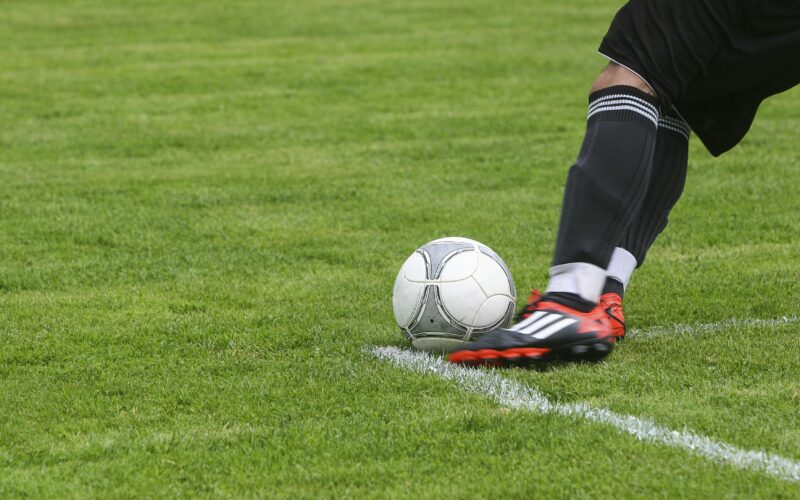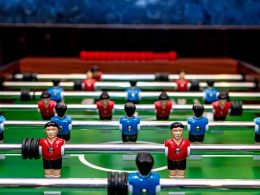College athletics are at a turning point. Between the recent attempts to unionize and the imminent House v. NCAA settlement, the status of college athletes has never been more uncertain.1[1]See generally Decision and Direction of Election, Trustees of Dartmouth College, Case No. 01-RC-325633 (2024); see also Becky Sullivan, Landmark Day for College Sports as Judge Holds Final Hearing on Major NCAA Settlement, NPR (Apr. 7, 2025, 8:21 PM), https://www.npr.org/2025/04/07/nx-s1-5354232/paying-college-athletes-ncaa-legal-settlement. However, another recent proposal in college sports has flown under the radar amidst these recent headlines: the Big Ten–ACC proposal to establish a year-round men’s college soccer season.2[2]See Daniel Libit & Luke Cyphers, Can U.S. Soccer’s Support Kick Year-Round College Model Into Gear?, SPORTICO (Feb. 23, 2025), https://www.sportico.com/leagues/college-sports/2025/us-soccer-college-year-round-pilot-program-1234829400/. To date, no court has ruled that college athletes are entitled to employee status. While some cases are pending, one factor that informs the courts’ decisions is the amount of time these athletes spend participating in the sport and the level of control the university maintains over the athletes.3[3]See e.g., Johnson v. National Collegiate Athletic Association, 108 F.4th 163, 180 (3rd Cir. 2024). If the Big Ten and ACC adopt this proposal and establish a year-round season, the universities’ unparalleled increased control over the athletes may weigh heavily in finding that the athletes are employees.
Men’s Soccer Scheduling Conventions
The current NCAA men’s soccer season operates as a fall sport, which runs for twelve weeks from August to December.4[4]See Griffin Cappiello, Monumental Changes Rumored to Come to College Soccer, THE TOWER (Feb. 6, 2025), https://cuatower.com/2025/02/monumental-changes-rumored-to-come-to-college-soccer/#:~:text=The%20proposed%20changes%20begin%20with,the%202026%20FIFA%20World%20Cup. This format aligns with traditional college sports such as football, where each team plays a guaranteed twelve regular-season games, and basketball, where the NCAA has recently approved a 22-week season.5[5]See CFB Select, How Many Games does College Football Play?, CFB SELECT (Mar. 2, 2023), https://cfbselect.com/2023/03/02/how-many-games-in-a-college-football-season/; see also Greg Johnson, First-Contest Dates on Mondays Approved for D1 Men’s, Women’s Basketball, NCAA (Oct. 8, 2024, 2:39 PM), https://www.ncaa.org/news/2024/10/8/media-center-first-contest-dates-on-mondays-approved-for-di-mens-womens-basketball.aspx. Since mid-2024, the United States Soccer Federation (“USSF”) has held talks with the Big Ten and ACC to create a two-semester men’s soccer season that would include thirty-two schools.6[6]See Libit & Cyphers, supra note 2. The USSF’s role in establishing the year-round season would “bypass the traditional NCAA legislative process,” given that the NCAA has rejected previous attempts to establish a year-round men’s college soccer season7[7]See id.
The asserted goal of the year-round season is to deal with match congestion in the current twelve-week season and provide better opportunities to develop players.8[8]See id. Under the current model, college soccer players train and compete for only four to five months. This is a stark contrast from the European-style academy system, which Major League Soccer (“MLS”) has also adopted, where prospects train and play year-round. The MLS also launched MLS NEXT Pro in 2022, a professional development league that provides a pathway from the teams’ academies to the MLS.9[9]See MLS NEXT PRO, What Is MLS NEXT Pro?, https://www.mlsnextpro.com/about/ (last visited Apr. 13, 2025). As of this year, MLS NEXT academies house more than 16,000 players, which feed into the MLS NEXT Pro teams.10[10]See Eben Novy-Williams, San Diego FC Owner Brings Rare Academy-First Portfolio to MLS, SPORTICO (Feb. 21, 2025, 12:01 AM), https://www.sportico.com/personalities/owners/2025/mohamed-mansour-san-diego-fc-owner-academy-right-to-dream-1234829097/. Notably, MLS NEXT Pro recognizes academy players on teams’ rosters as amateurs.11[11]See MLS NEXT PRO, Roster Guidelines, https://www.mlsnextpro.com/about/roster-guidelines (last visited Apr. 19, 2025). If the Big Ten, ACC, and USSF achieve their goal of establishing a year-round men’s college soccer season to compete for the best talent, the schools that partake in the year-round season will face serious questions as to whether their players are still amateurs or should be considered employees.
Legal Frameworks for Assessing College Athletes as Employees
That question might be answered by the framework provided in Johnson v. NCAA.12[12]See Johnson, 108 F.4th at 167. In Johnson, college athlete plaintiffs asserted Fair Labor Standards Act (“FLSA”) violations against their universities and the NCAA.13[13]See id. The athletes alleged that they should have been classified as employees and thereby were entitled to federal minimum wage compensation for the time they spent practicing and playing their sport.14[14]See id. Defendants moved to dismiss the claim, arguing that the amateurism tradition should shield them from FLSA claims.15[15]See id. The Third Circuit disagreed and remanded the case to the district court to apply a new version of the economic realities analysis to determine whether athletes are employees of their universities.16[16]See id. Specifically, the Third Circuit instructed the district court to consider whether: (1) the athletes perform services for the university, (2) the services are “necessarily and primarily for the [other party’s] benefit,” (3) the athletes are under the party’s “control or right of control,” and (4) the athletes provide their services “in return for ‘express’ or ‘implied’ compensation or ‘in-kind benefits.’”17[17]See id. at 180. While all four factors are relevant to analyze the Big Ten-ACC proposal, the universities’ “right of control” of the athletes would likely take on heightened significance given the expanded in-season schedule.
Also relevant to assessing whether year-round college soccer tilts the playing field toward considering those athletes as employees is the decision in the Dartmouth Men’s Basketball unionization petition. Members of the Dartmouth Men’s Basketball team petitioned the National Labor Relations Board (“NLRB”) Boston regional director, asserting that they were employees of Dartmouth and entitled to unionize.18[18]See Trustees of Dartmouth College at 2. In Trustees of Dartmouth College, the Boston regional director agreed, finding that the school had the right to control the work performed by the basketball team and that the players performed work in exchange for compensation.19[19]See id. In reaching this decision, the regional director reasoned that the school’s student-athlete handbook functioned as an employee handbook and the players received compensation such as “early read” financial aid packages, equipment, apparel, meals, lodging, and tickets to games.20[20]See id. at 18-21. The Dartmouth Men’s Basketball team voted to unionize on March 5, 2024, establishing the first ever successful college-athlete union. On December 31, 2024, however, the team retracted its petition and voluntarily dismissed all NLRB proceedings based on concerns with the incoming administration’s position on college athletes’ employee status. See Aryanna Qusba & Annabelle Zhang, Dartmouth Men’s Basketball Team Drops Effort to Unionize, THE DARTMOUTH (Jan. 2, 2025), https://www.thedartmouth.com/article/2025/01/dartmouth-mens-basketball-team-drops-effort-to-unionize. Both Johnson and Trustees of Dartmouth College focused on the economic relationship between universities and their student-athletes, emphasizing the control the universities exercised over the athletes in finding employee status.21[21]See Trustees of Dartmouth College at 2.
Applying the Employee-Status Tests to Year-Round College Soccer Players
If a court were to apply the Johnson test to Big Ten and ACC men’s soccer players, it would be more likely to find the athletes are employees if they participate in a year-round season. First, a court would likely determine that the players perform services for their universities-namely, training and playing on the university-sponsored soccer team. A harder question is whether the services are primarily for the school’s benefit. Universities may try to distinguish college soccer from revenue-generating sports like football and basketball. However, Trustees of Dartmouth College noted that the profitability of a business is not decisive in determining the employee status of individuals who provide services to the business.22[22]See id. at 18. Courts can consider other benefits, and in the case of the Big Ten-ACC proposal, it may be relevant that the conferences believe their soccer programs will be more relevant if the collegiate calendar aligns with professional leagues. Redesigning the college soccer model to generate more professional-grade talent will attract commercial opportunities and perhaps USSF funding.23[23]See Cappiello, supra note 4; Libit & Cyphers, supra note 2; see also Katie Davis, The Financial and Operational Challenges of Year-Round Men’s Soccer, JAMES MOORE (Mar. 13, 2025), https://www.jmco.com/articles/collegiate-athletics/challenges-of-year-round-mens-soccer/.
Turning to the universities’ right of control over the athletes, this factor would likely be most consequential. Unlike the athletes in Trustees of Dartmouth College, who play their sport for only a few months, the universities would exercise in-season control over the soccer players year-round.24[24]See Johnson, supra note 5. This unprecedented control is a marked increase from the current 12-week college soccer season and analogous to the obligations of professional soccer players, who are of course employees of their teams.25[25]See Cappiello, supra note 4. Finally, a court would likely hold that the soccer players provide their services for in-kind benefits. Although this factor would depend on the factual record, Trustees of Dartmouth College demonstrates that it may be sufficient that college athletes receive equipment, meals, lodging, and tickets to their games.26[26]See Trustees of Dartmouth College at 19-20.
Big Ten and ACC universities may challenge employee status for college soccer players by analogizing year-round men’s college soccer programs to MLS NEXT academies. Academy youth players are considered amateurs, not employees, despite residency and homestay programs that house and educate players from other regions.27[27]See Charles Boehm, Audi 1v1: Residency programs broaden the scope, depth of MLS academies, MLS (Jun. 17, 2020), https://www.mlssoccer.com/news/audi-1v1-residency-programs-broaden-scope-depth-mls-academies. However, college athletes could rely on Johnson to counter that academy youth play solely for recreational and noncommercial purposes, and lose eligibility when they turn 19.28[28]See id. Contrast NCAA soccer where athletes receive scholarships and other benefits and can access opportunities to exploit their NIL29[29]See 2024-2025 MLS NEXT Rules & Regulations §§ I, XI(a), https://images.mlssoccer.com/image/upload/v1725992749/assets/documents/MLS_NEXT_Rules_and_Regulations_2024-2025_Final_pghczd.pdf.. In that light, year-round college athletes are more analogous to MLS NEXT Pro players who have signed professional contracts.30[30]See Roster Guidelines, supra note 11.
Alternatively, universities could make participation on a sports team contingent on registering for an athletics-related degree, thus bolstering the argument that the athletes are not employees. For example, the universities could design a minor course of study that builds on the lessons athletes learn from their sports experience, such as the business of sports, broadcasting, or sports medicine. By explicitly defining the athletic experience as an integral part of a structured academic program, universities could show that the primary purpose of the athlete’s presence at the institution is education, with sports as a component of that education, rather than a separate, compensated job. However, as the Third Circuit acknowledged in Johnson, the degree to which sports participation is detrimental to academic performance may impede the course-study approach to avoid employee status.31[31]See Johnson, 108 F.4th at 180.
The Big Ten-ACC proposal for a year-round soccer season could change the landscape of college soccer. While the schedule change would help college soccer compete with the likes of MLS NEXT Pro for top talent, the proposal poses significant questions regarding the employee status of college soccer players. With the employee status of seasonal athletes in football and basketball already in question, an athlete’s year-round commitment to a college soccer program is likely to tilt the balance in favor of finding them to be employees.
If the universities and conferences were to acknowledge that it is only a matter of time until courts confer employee status to these athletes, they may be faced with the decision to affirmatively recognize these athletes as employees.32[32]See e.g., William W. Berry III, Conference-Employees and Student-Athletes, 104 TEX. L. REV. __ (forthcoming 2025) at 24-32, available at SSRN: https://ssrn.com/abstract=5143136. Although this may seem counterintuitive, the universities and conferences would obtain two key benefits: collective bargaining and antitrust immunity.33[33]See id. at 37-41. The question would remain, however, as to who would receive employer status: the conferences, universities, or USSF.
Written by: Michael J. Havens
Michael is a 2026 J.D. Candidate at Brooklyn Law School.
[1] See generally Decision and Direction of Election, Trustees of Dartmouth College, Case No. 01-RC-325633 (2024); see also Becky Sullivan, Landmark Day for College Sports as Judge Holds Final Hearing on Major NCAA Settlement, NPR (Apr. 7, 2025, 8:21 PM), https://www.npr.org/2025/04/07/nx-s1-5354232/paying-college-athletes-ncaa-legal-settlement.
[2] See Daniel Libit & Luke Cyphers, Can U.S. Soccer’s Support Kick Year-Round College Model Into Gear?, Sportico (Feb. 23, 2025), https://www.sportico.com/leagues/college-sports/2025/us-soccer-college-year-round-pilot-program-1234829400/.
[3] See e.g., Johnson v. National Collegiate Athletic Association, 108 F.4th 163, 180 (3rd Cir. 2024).
[4] See Griffin Cappiello, Monumental Changes Rumored to Come to College Soccer, The Tower (Feb. 6, 2025), https://cuatower.com/2025/02/monumental-changes-rumored-to-come-to-college-soccer/#:~:text=The%20proposed%20changes%20begin%20with,the%202026%20FIFA%20World%20Cup.contract/#:~:text=Ohtani’s%20contract%20includes%20an%20extremely,91%20million%20by%20deferring%20payment.
[5] See CFB Select, How Many Games does College Football Play?, CFB Select (Mar. 2, 2023), https://cfbselect.com/2023/03/02/how-many-games-in-a-college-football-season/; see also Greg Johnson, First-Contest Dates on Mondays Approved for D1 Men’s, Women’s Basketball, NCAA (Oct. 8, 2024, 2:39 PM), https://www.ncaa.org/news/2024/10/8/media-center-first-contest-dates-on-mondays-approved-for-di-mens-womens-basketball.aspx.
[6] See Libit & Cyphers, supra note 2.
[7] See id.
[8] See id.
[9] See MLS NEXT Pro, What Is MLS NEXT Pro?, https://www.mlsnextpro.com/about/ (last visited Apr. 13, 2025).
[10] See Eben Novy-Williams, San Diego FC Owner Brings Rare Academy-First Portfolio to MLS, Sportico (Feb. 21, 2025, 12:01 AM),https://www.sportico.com/personalities/owners/2025/mohamed-mansour-san-diego-fc-owner-academy-right-to-dream-1234829097/.
[11] See MLS NEXT Pro, Roster Guidelines, https://www.mlsnextpro.com/about/roster-guidelines (last visited Apr. 19, 2025).
[12] See Johnson, 108 F.4th at 167.
[13] See id.
[14] See id.
[15] See id.
[16] See id.
[17] See id. at 180.
[18] See Trustees of Dartmouth College at 2.
[19] See id.
[20] See id. at 18-21. The Dartmouth Men’s Basketball team voted to unionize on March 5, 2024, establishing the first ever successful college-athlete union. On December 31, 2024, however, the team retracted its petition and voluntarily dismissed all NLRB proceedings based on concerns with the incoming administration’s position on college athletes’ employee status. See Aryanna Qusba & Annabelle Zhang, Dartmouth Men’s Basketball Team Drops Effort to Unionize, The Dartmouth (Jan. 2, 2025), https://www.thedartmouth.com/article/2025/01/dartmouth-mens-basketball-team-drops-effort-to-unionize.
[21] See Trustees of Dartmouth College at 2.
[22] See id. at 18.
[23] See Cappiello, supra note 4; Libit & Cyphers, supra note 2; see also Katie Davis, The Financial and Operational Challenges of Year-Round Men’s Soccer, James Moore (Mar. 13, 2025), https://www.jmco.com/articles/collegiate-athletics/challenges-of-year-round-mens-soccer/.
[24] See Johnson, supra note 5.
[25] See Cappiello, supra note 4.
[26] See Trustees of Dartmouth College at 19-20.
[27] See Charles Boehm, Audi 1v1: Residency programs broaden the scope, depth of MLS academies, MLS (Jun. 17, 2020), https://www.mlssoccer.com/news/audi-1v1-residency-programs-broaden-scope-depth-mls-academies.
[28] See id.
[29] See 2024-2025 MLS NEXT Rules & Regulations §§ I, XI(a), https://images.mlssoccer.com/image/upload/v1725992749/assets/documents/MLS_NEXT_Rules_and_Regulations_2024-2025_Final_pghczd.pdf.
[30] See Roster Guidelines, supra note 11.
[31] See Johnson, 108 F.4th at 180.
[32] See e.g., William W. Berry III, Conference-Employees and Student-Athletes, 104 Tex. L. Rev. __ (forthcoming 2025) at 24-32, available at SSRN: https://ssrn.com/abstract=5143136.
[33] See id. at 37-41.




